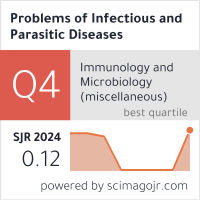ISONIAZID - MONORESISTANT TUBERCULOSIS IN BULGARIA
DOI:
https://doi.org/10.58395/pipd.v48i1.29Keywords:
tuberculosis, isoniazid, resistanceAbstract
Background. Isoniazid is a common drug in the treatment regimens for TB infection. Monoisoniazid resistance reduces the probability of a successful treatment outcome and increases the risk of acquiring additional drug resistance.
Material and methods. For the period 2015-2016 a total of 36 TB cases were confirmed in NRL TB, Sofia, as isoniazid-monoresistant Mycobacterium tuberculosis complex. Minimum inhibitory concentration testing for isoniazid was conducted with BАСТЕС MGIT 960 System in the following concentrations of the drug: 0.1 μg/ml, 0.15μg/ml, 0.2μg/ml, 0.3μg/ml, 0.4μg/ml. Molecular testing was performed with GenoType ® MTBDRplus in order to detect the most common mutations associated with resistance to isoniazid.
Results. Only 25% of the tested M. tuberculosis complex isolates with phenotypic isoniazid monoresistance had the S315T1 mutation in katG; all isolates were with MIC over 0.4 μg/ml. C15T in the promoter region of inhA was detected in 22.22% of cases and only 1 of them showed MIC below 0.4 μg/ml. No mutations were detected in nearly half of the cases (n=19, 52.78%) and most of these isolates were with lower MIC values (n=12). Conclusion. The rapid testing with GenoType ® MTBDRplus can be used as a screening procedure indicating whether further examination of isoniazid MIC is relevant in resistant M. tuberculosis and whether higher doses could be considered.
Downloads
References
Jenkins HE, Zignol M, Cohen T. Quantifying the Burden and Trends of Isoniazid Resistant Tuberculosis, 1994–2009. PLoS ONE. 2011; 6(7):e22927.
Palomino JC, Martin A. Drug Resistance Mechanisms in Mycobacterium tuberculosis. Antibiotics. 2014; 3(3):317-340.
European Centre for Disease Prevention and Control/WHO Regional Office for Europe. Tuberculosis surveillance and monitoring in Europe 2017, table 13, p. 60.
European Centre for Disease Prevention and Control/WHO Regional Office for Europe. Tuberculosis surveillance and monitoring in Europe 2018 – 2016 data; table 11, p.97.
Seifert M, Catanzaro D, Catanzaro A, Rodwell TC. Genetic Mutations Associated with Isoniazid Resistance in Mycobacterium tuberculosis: A Systematic Review. PLoS ONE. 2015; 10(3):e0119628.
Bachiyska E, Yordanova S, Atanasova Y, et al. MDR tuberculosis in Bulgaria – associated genetic mutations. InSpiro. 2016; 4(37):36-40. In Bulgarian
Bachiyska E. Microbiological studies on the aetiology of MDR tuberculosis in Bulgaria. (Doctoral thesis, Sofia, 2013). In Bulgarian
Yordanova S, Bachiyska E, Atanasova Y, et al. MDR-TB with additional fluoroquinolone resistance in Bulgaria. Probl Infect Parasit Dis. 2015; 43(2):8-11.
Yordanova S. Microbiological studies on XDR tuberculosis in Bulgaria. (Doctoral thesis, Sofia, 2017). In Bulgarian
Ghodousi A, Tagliani E, Karunaratne E, Niemann S, Perera J, Köser CU, Cirillo DM. Isoniazid resistance in Mycobacterium tuberculosis is a heterogeneous phenotype composed of overlapping MIC distributions with different underlying resistance mechanisms. Antimicrob Agents Chemother. 2019; 63:e00092.
Ministry of Health. Methodological guidance on the therapeutic behaviour in cases of drug- resistant tuberculosis. Sofia, 2016; p. 6-32. In Bulgarian






